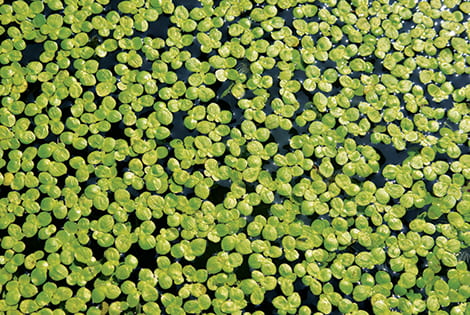Duckweed is a very small floating plant about the size of a pencil eraser. It has shoe-sole shaped leaves with a small, hair-like root hanging below. Since duckweed floats on the surface of the pond, it is commonly mistaken for and treated as if it is algae. Unfortunately, algaecides have no effect on duckweed but there are a couple treatments you can do to keep the prolific duckweed at bay.
Identify: Duckweed or Watermeal?
Duckweed is a very small, light green, free-floating plant with a single hair-like root and three 1/16- to 1/8-inch long leaves, or fronds. It tends to grow in dense colonies in quiet water that is undisturbed by waves. You can fit six to eight of these plants of the tip of your finger.
Watermeal, another invasive plant that can be mistaken for duckweed, is also light green and free-floating, but it has no roots and is more of a grainy, seed-type plant. It is also much smaller than duckweed; at less than 1 millimeter in size, you can fit 10 to 20 of them on the tip of your finger.
Duckweed and watermeal colonies can provide a habitat for microscopic critters and forage for hungry ducks, but the plants can reduce oxygen in the water if they grow to cover a lake or pond's surface. That could compromise your fish and cut off sunlight to underwater plants.
Treat Effectively
Short Term: Ultra PondWeed Defense or KnockDown Defense used with Treatment Booster Plus are your go-to herbicide products for short-term control of duckweed and other invasive aquatic weeds. These herbicides provide broad-spectrum pond weed control in slow-moving water and kill what is actively growing in your pond. If duckweed has not completely taken over your water surface, you may notice algae growth mixed in with the weeds – in which case you will need to treat the algae first.
Long Term: For long-term control, a herbicide like fluridone, which is found in
Airmax WipeOut, is recommended. When applied in early spring, the herbicide controls established plants in 30 to 60 days, and in 90 days, your pond will have full pond protection. Because exposure to sunlight can reduce WipeOut's effectiveness, use in combination with Pond Dye. If you use your pond water to irrigate, you will need to wait 30 days following treatment.
Improve Overall Pond Quality: In addition to managing your menace with herbicides, you should also reduce muck and aerate the water. The products in the
ClearPAC Plus Pond Care Package – including PondClear, MuckAway and EcoBoost PRx – will help reduce the submerged and suspended organic debris. Combine that with Airmax Aeration, and your water will stay crystal clear all season long.
Last Updated: July 1, 2024

